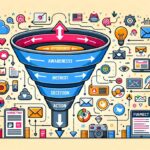6 landing page design tips to boost conversions

In today’s ever-evolving digital marketplace, businesses face a relentless challenge: transforming mere visitors into loyal customers. A mere online presence is no longer sufficient in a landscape brimming with digital interactions. Instead, successful businesses craft a systematic approach—a seamless journey that attracts, engages, and converts leads into customers.
The Role of Sales Funnels and Landing Pages
Central to this strategy are sales funnels and landing pages. Each plays a pivotal role in creating a streamlined path for customers, enhancing their experience and boosting conversion rates. When these components are expertly crafted and harmoniously integrated, they provide businesses with the strategic leverage needed to outshine the competition.
Sales funnels act as a structured roadmap guiding potential customers through various stages: awareness, interest, decision, and action. This model not only helps businesses visualize the customer journey but also allows for fine-tuning at each stage, ensuring a seamless transition from one phase to the next. By optimizing the journey, businesses can create effective sales workflows that nurture prospects and offer valuable insights into customer preferences.
The Power of a Well-Designed Landing Page
Complementing the sales funnel is the all-important landing page—often the first touchpoint between the visitor and your brand. A well-crafted landing page aims to convert casual visitors into leads by focusing on specific objectives, such as completing a purchase, signing up for a newsletter, or downloading content. It achieves this through engaging elements like compelling headlines, persuasive calls-to-action (CTAs), and strategic layouts designed to capture visitor attention.
Integrating Email Automations
Adding another layer to this strategy is the integration of email automations. Automated emails maintain a consistent, personalized communication line with potential customers, ensuring engagement is sustained throughout the funnel stages. Tailored to fit different phases in the sales funnel, these emails are crucial for effectively nurturing leads and strengthening customer relationships.
Simplifying the Process with ClickFunnels
To streamline these processes, businesses can leverage platforms like ClickFunnels, which offers a free trial. ClickFunnels is a comprehensive tool designed to integrate all elements of sales funnels, landing pages, and email automations into a cohesive, easy-to-manage system. By employing ClickFunnels, businesses can focus on growth and results, rather than technical intricacies, effortlessly designing and optimizing their marketing strategies.
This article delves deeper into the intricacies of creating compelling sales funnels and designing high-converting landing pages. We’ll spotlight essential landing page design tips and strategies to maximize your business’s potential. Whether you’re new to this realm or refining your approach, understanding these core elements can set your business on a path to accelerated growth and lasting success.
Understanding the Sales Funnel
In the dynamic landscape of digital marketing, a sales funnel transforms from a mere theoretical concept into a strategic model that meticulously outlines the journey a potential customer undertakes—from initial engagement with your brand to the final purchase decision. At its essence, a well-defined sales funnel allows businesses to visualize the customer’s journey, facilitating every stage to be optimized for conversion and profoundly impacting buying behavior.
The funnel enables companies to segment the customer journey into distinct phases, honing in on what prospects need at each step. Understanding and optimizing each of these phases provides invaluable insights into creating robust sales workflows and executing successful marketing campaigns.
Awareness
The journey begins with the awareness stage, traditionally located at the top of the funnel. Here, the main objective is to capture the attention of your target audience. This is achieved through numerous strategies, such as content marketing, social media engagement, and other digital outreach initiatives. At this point, it is essential to introduce your product or service subtly, planting a seed of interest and curiosity in potential customers’ minds.
Consideration
As prospects journey into the funnel, they enter the consideration phase. During this stage, potential customers actively seek information, comparing different solutions and weighing their options meticulously. The focus should be on providing valuable insights including product details, comparisons, case studies, and customer testimonials. Especially in this phase, landing page design tips can play a significant role, as well-optimized landing pages effectively communicate the unique benefits of your offerings, facilitating a smoother transition to the next stage.
Decision
Near the bottom of the funnel lies the decision stage. Here, potential buyers are poised to make a commitment, and your task is to ease the decision-making process. This is accomplished by leveraging clear calls-to-action and offering transparent information about pricing and value propositions. Ensuring this process is as frictionless as possible can turn the browsing audience into paying customers.
Understanding the granular intricacies of each phase enables businesses to refine their marketing strategies, creating robust sales workflows that not only satisfy but surpass customer expectations. This approach enhances the overall customer experience and significantly boosts conversion rates, transforming prospects into loyal, repeat customers.
For enterprises keen on optimizing their sales funnels and landing pages, a comprehensive solution like ClickFunnels comes highly recommended. ClickFunnels offers a streamlined platform for businesses, allowing for seamless design and management of every aspect of sales funnels and landing page design. By leveraging their free trial, businesses can explore the platform’s extensive capabilities, driving enhancements in customer engagement and conversion outcomes.
Integrating an optimized sales funnel into your marketing strategies is crucial, ensuring that every journey your potential customer takes is both engaging and efficient, ultimately fostering sustainable growth and success.
Designing Landing Pages that Convert
Landing pages are pivotal in shaping the first impression your brand makes on visitors, underscoring the critical importance of their design. An effective landing page can be the bridge between a casual browser and a loyal customer, capturing attention and channeling it into meaningful actions. Below, we explore essential landing page design tips that can help transform a good page into a great one, maximizing both engagement and conversion potential.
Create a Persuasive Headline
The headline is the landing page’s beacon, the first element that draws in visitors. It must be clear, concise, and compelling, speaking directly to the visitor’s needs or points of interest. A strong headline not only arrests attention but encapsulates the core value of what you offer, prompting further exploration.
Enhance User Experience
A pivotal part of any landing page design is ensuring an outstanding user experience. An intuitive and visually appealing layout helps guide visitors naturally through the content. Employ the strategic use of white space and appealing visuals to prevent overwhelming visitors, and choose clear, readable fonts to maintain clarity in your messaging.
Simplify Your Forms
When your goal is to capture leads, simplicity is your ally. Forms should be streamlined to require only the most necessary information, avoiding the pitfall of dissuading potential leads with lengthy demands. The principle here is simple: the fewer the fields, the higher the likelihood of form completion.
Employ Strong Calls-to-Action
The Call-to-Action (CTA) is a cornerstone of any landing page, needing to be both prominent and action-oriented. Use dynamic phrases like “Get Started” or “Claim Your Free Trial” rather than the generic “Submit.” CTAs should be distinctive, with contrasting colors to ensure they stand out and are placed in strategic positions to lead visitors naturally toward their desired steps.
Build Trust with Social Proof
Trust is non-negotiable when converting visitors into customers. Incorporate elements like testimonials, case studies, and trust badges to bolster credibility. Seeing positive experiences from others can be a powerful motivator for visitors to engage further with your brand.
Conduct A/B Testing
Continuous A/B testing is vital to enhancing your landing page’s effectiveness. Test different aspects—headlines, visuals, CTAs—to determine which variations best resonate with your audience. The insights gained from these tests are indispensable in fine-tuning your page design for maximum impact.
For those aiming to master the art of landing page design, consider leveraging tools like ClickFunnels. Offering a free trial, ClickFunnels provides a comprehensive suite designed for easy creation and management of highly converting landing pages and sales funnels. It empowers businesses to refine and optimize their marketing strategies effortlessly, ensuring your landing pages not only attract but convert visitor interest into meaningful engagement.
In summary, effective landing page design hinges on crafting each element with conversion in mind. By focusing on these strategies, you can create landing pages that not only capture the audience’s attention but also transform their engagement into actionable business outcomes.
The Power of Email Automations
In the realm of digital marketing, email automation has revolutionized how businesses manage and enhance their sales workflows. By offering personalized, timely communications, automated emails allow businesses to nurture leads effectively as they move through various stages of the sales funnel, ensuring that customer engagement is consistent and impactful.
Enhancing Engagement Through Automation
Email automation empowers businesses to leverage precision in their customer interactions, ensuring that recipients receive relevant information exactly when they need it. By automating key interactions, businesses can maintain a steady flow of communication that resonates with potential customers, encouraging them to proceed seamlessly along the funnel.
Automation takes away the labor-intensive task of manually sending emails, instead, allowing focus on crafting messages that are aligned with customer needs and behaviors. This not only saves time but also ensures that prospects receive tailored communications that are likely to enhance their experience and drive conversions.
Types of Automated Emails to Bolster Your Sales Funnel
Certain types of automated emails are essential in supporting a robust sales funnel:
Welcome Emails: Onboarding emails set a positive first impression, welcoming new subscribers and providing an introduction to your brand and offerings.
Lead Nurturing Sequences: These emails engage potential customers by sharing resources, insights, or offers that align with their interests, guiding them from consideration to decision-making stages.
Cart Abandonment Reminders: These strategic reminders encourage customers who have left items in their cart to return and complete their purchase, often coupled with incentives.
Follow-Up Emails: Post-interaction communications, such as thanking customers after a purchase or soliciting feedback, help to reinforce brand loyalty and improve user experience.
Seamless Integration with Your Strategy
Integrating email automation into a cohesive marketing strategy ensures that every communication is aligned with audience expectations and business goals. Platforms like ClickFunnels offer a comprehensive solution to this challenge. ClickFunnels is built to simplify and streamline the creation of high-converting sales funnels, paired with powerful landing pages and automated email marketing.
With ClickFunnels, businesses can design an integrated strategy that seamlessly connects automated emails with other components of the sales funnel. This capability allows for the continuous engagement of customers, nurturing them towards conversion with precision and relevance. Whether you are just starting or looking to refine your processes, utilizing tools like ClickFunnels ensures that your business can maintain a competitive edge by leveraging automation to its fullest potential.
In conclusion, a well-implemented email automation strategy is key to maintaining consistent and meaningful interactions with your audience. By facilitating connection at each critical juncture of the funnel, automated emails not only enhance the customer journey but also drive conversion rates higher, ultimately contributing to your business’s sustained growth and success.
Bringing It All Together: Optimizing Your Strategy
Successfully combining sales funnels, landing pages, and email automation into a single, cohesive strategy is critical to driving meaningful customer interactions and enhancing conversion rates. By strategically aligning these components, businesses not only improve customer engagement but also ensure each part of their marketing machine works seamlessly to boost overall sales performance.
Crafting a Cohesive Strategy
The foundation of a robust digital marketing strategy is ensuring that sales funnels, landing pages, and email automation are aligned and integrated smoothly. Each component plays a unique role that, when harmonized, creates a compelling customer journey that effectively transitions prospects from awareness to action.
Sales funnels represent the structured path that guides potential customers through various stages—from generating awareness and capturing interest to facilitating decision-making and prompting action. A finely-tuned sales funnel gives businesses insights into consumer behavior, allowing them to refine their approach and ensure all interactions are tailored towards conversion.
Landing pages act as critical touchpoints within this journey, often serving as the first impression of your brand. By employing best practices in landing page design, such as engaging content, persuasive CTAs, and streamlined forms, businesses can maximize the likelihood of turning traffic into leads.
Email automation complements these efforts by delivering timely and personalized messages that nurture leads through the sales funnel. These emails are crafted to keep potential customers engaged, deliver valuable content and information, and ultimately guide them towards a purchase decision.
Enhancing Performance Through Alignment
Aligning these components ensures a seamless experience for the customer while maximizing the return on marketing efforts. Here’s how to achieve exceptional alignment and performance:
Utilize data-driven insights to continuously monitor and optimize each stage of the customer journey. Analyze where prospects drop off and refine those touchpoints to reduce friction and boost conversion.
Regularly perform A/B testing on your landing pages to discover what configurations result in the highest engagement rates. This practice helps maintain the effectiveness of your landing pages over time.
Deploy personalization strategies in your email automations, tailoring messages to resonate with each segment of your audience. This level of engagement increases the likelihood of moving them further down the funnel.
Leveraging Powerful Tools
To execute this comprehensive strategy with efficiency and precision, leveraging the right tools and platforms is key. A solution like ClickFunnels offers a robust suite of features that can simplify the process of creating integrated sales funnels, designing high-converting landing pages, and automating email campaigns.
ClickFunnels is designed to streamline the development of complex marketing strategies, allowing businesses to focus on growth and optimization rather than technical challenges. By taking advantage of the free trial, businesses can experiment with and refine these components, ensuring each element works in harmony to drive sustainable growth.
In summary, by strategically aligning sales funnels, landing pages, and email automation, supplemented by powerful tools like ClickFunnels, businesses can create an optimized marketing approach that enhances customer interactions, improves conversion rates, and strengthens the bottom line.





